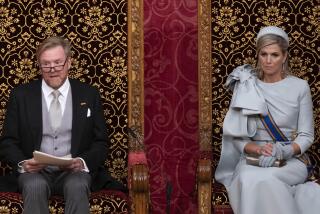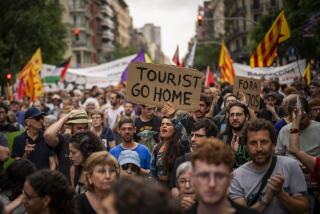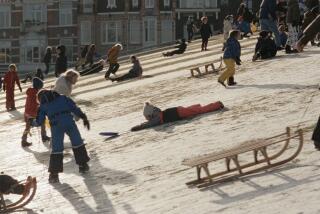A Pragmatic Spirit Guides the Dutch
AMSTERDAM â What is it about the Dutch?
They sell marijuana joints and hashish-laced âspace cakesâ in specialty shops. Prostitutes stand brazenly in skimpy lingerie under soft neon light on display for window-shopping customers and tourists. And the country lets its doctors kill patients who want to die.
Sex shops and dope-selling âcoffeehousesâ are overtaking wooden shoes and windmills as popular images of Holland.
In the last year, Parliament enacted laws legalizing brothels and regulating the sex trade; sanctioning gay marriages and investing those unions with full rights; and approving euthanasia conducted under strict guidelines. Now there is talk of prescribing suicide pills for the elderly.
Some call the Dutch pioneers of progressiveness. Others wonder if theyâre not degenerates.
The Vatican described the gay marriage law as âa grave attack on the family,â and its newspaper denounced the euthanasia bill, wondering how âsuch a macabre choice can be seen as âcivilâ and âhumanitarian.â â Germanyâs Greens party called the euthanasia decision âregrettable.â
But while all these laws attracted worldwide attention, their evolution was so gradual here that the Dutch hardly noticed when they were finally adopted and quietly went into force. All were debated for decades, then carefully crafted into bills reflecting a broad consensus.
Why is a country of 16 million people, one of the smallest and least vocal in Europe, at the forefront of liberal legislation? And why did it happen in a country that embraced the most dour, regimented stream of Christendom, Calvinism?
The Dutch say they are just as conservative as other Europeans, only more sensible about dealing with alternative lifestyles, employing an art of pragmatism drawn from deep in their history.
Decriminalization gives authorities greater control over activities that happen anyway, they argue. After the Netherlands overturned a widely ignored 1912 ban on brothels last year, these houses became taxpaying establishments required to give standard employee benefits. The law also was designed to weed out illegal immigrants, underage girls and forced prostitution.
Euthanasia traditionally accounts for about 3,500 deaths a year in the Netherlands, a rate the Dutch say is secretly matched in other countries. But the law passed in April firmly regulates the conditions under which doctors may help patients end their lives.
Historian Han van der Horst says the Dutch have long followed the rule of âthe sovereignty of oneâs own domainâ--in other words, live and let live.
Far from being a homogeneous nation, the Netherlands is a patchwork of minorities and subcultures, says van der Horst, author of âThe Low Sky,â a book intended to explain the Dutch to uncomprehending outsiders.
âIn such a system, tolerance and respect for private lifestyles is essential because the alternative is civil war,â he said in an interview.
Today, only a few miles from the wide-open cities of Amsterdam and Rotterdam is a broad Bible belt, where shops are closed on Sunday and where a fundamentalist Christian organization claims the bulk of its half-million members.
Such coexistence is a product of the historical divide between Roman Catholics and Protestants, a defining feature of the Netherlandsâ creation as a nation in the 16th century.
In the Calvinist north, Catholic churches were outlawed but were ignored as long as the exteriors did not look like churches. It was understood no one would peek inside, thus allowing an unwritten freedom of worship. Portuguese Jews fleeing the Inquisition also were welcomed--as long as they contributed to the booming Dutch economy.
This blind-eye policy, what the Dutch call âthe expediency principle,â is still a hallmark of Dutch jurisprudence. The sale of hashish and marijuana is illegal, but 850 coffeehouses sell marijuana joints or 5-gram packets of hash without fear of prosecution if they do not sell liquor too.
Such tolerance doesnât extend to dealing in hard drugs. Police say 17% of inmates in Dutch prisons are serving time for drug offenses.
The government runs awareness campaigns and education programs to discourage drug use. Despite the easy availability of drugs, a 1997 study by the Center for Drugs Research at Amsterdam University said marijuana usage is twice as high in the United States as in the Netherlands--9% of Americans older than 12 tried it at least once that year, compared with 4.5% here.
Visitors are often taken aback by the freewheeling ways of Amsterdam, a graceful city of gabled centuries-old canal-side brick houses. People going to an organ concert in the spired 14th century Oude Kerk, or Old Church, have to walk through the heart of the frenetic red light district, with its live sex shows, storefronts displaying all manner of sex paraphernalia, gay bars and the famous picture-window prostitutes.
Yet it has little of the seediness of such districts elsewhere in Europe. Middle-aged couples walk hand in hand along the cobbled streets, and tourist boats glide through the canals past notorious sex clubs.
Prostitution--female and male--has a rich heritage here. In the 17th century, a thriving sex trade serviced Amsterdam, then the richest city on Earth and the hub of a shipping and colonial empire that stretched from the Americas to southern Africa and the East Indies.
Brothels, madams and buxom women were common themes in sermonizing genre paintings by Dutch masters. Sometimes thinly disguised as moralizing tracts, handbooks and guides were published that told customers exactly what they wanted to know.
Boris Dittrich, a lawmaker who was a primary mover of the liberalization bills, says tolerance came naturally to a mercantile nation like the Netherlands.
âHistorically, the Dutch were sailors and merchants who traveled the world. They came back with new ideas, new products, new ways of seeing things,â he said in an interview. âAt the same time, we were a people of the clergy, a very religious people. We had to find a way to live together.â
Recent decades of immigration have imported new cultures and religions. Migration started with people from the former Dutch colonies of Suriname and Indonesia. In the labor-shortage years of the 1960s, workers came first from Italy and Spain, then from Morocco and Turkey.
Today, 1.4 million Dutch citizens --nearly 9% of the total--are from non-Western immigrant families.
Racially mixed couples are a common sight, even on Dutch TV soap operas. The 33-man national soccer squad has seven players from immigrant families, and they are among the countryâs heroes.
But privately the Dutch may not be as open-minded as their laws suggest.
Immigrants complain of subtle racism, and there are few nonwhite political leaders. Although the far-right party lost its last seat in the 1994 parliamentary election, an antidiscrimination hotline receives thousands of calls every year, and there often is vocal public resistance to new refugee centers.
Last month 70 Jewish graves were desecrated with Nazi slogans in a central Dutch town, and another cemetery was attacked a few weeks ago.
The Netherlands also lags in accepting women prominently in the workplace. The head of state is Queen Beatrix, and one-third of Parliament is female, but women are virtually absent in senior corporate positions.
U.S. Ambassador Cynthia Schneider speaks about a glass ceiling for women. âIn my time in the Netherlands, attending high-level business meetings or social events, all too often I have noticed that I am one of a handful of--or even the only woman in the room,â she said at a conference last year.
More to Read
Sign up for Essential California
The most important California stories and recommendations in your inbox every morning.
You may occasionally receive promotional content from the Los Angeles Times.










